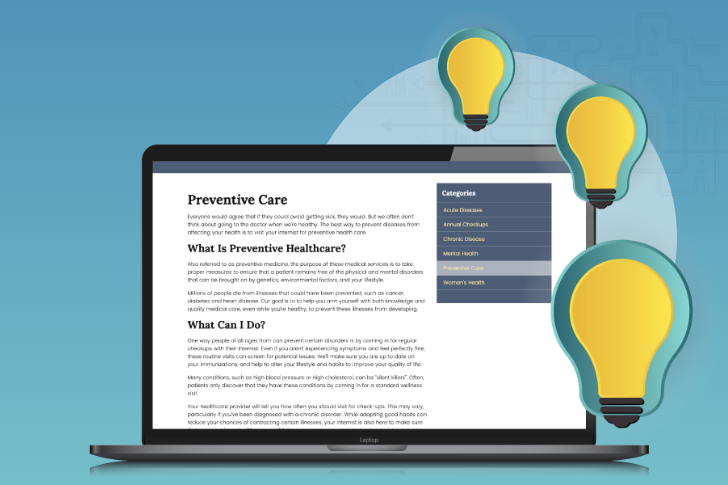Design Tips For Creating A Professional Medical Website
The interior designs of physician offices aren’t identical. A pediatrician’s office may feature brightly colored walls and a built-in play area for children, for example. And a sports medicine specialist’s office may be decorated with framed images of renowned athletes. Offices are designed to appeal to each specific patient population. Web design should do that, too.
Your practice’s website reflects your practice’s public persona. A stunning medical website design can be a powerful way to attract patients and boost your practice’s reputation. To maximize your website’s potential, you should aim for a well-organized and informative web presence.
Some “best practices” apply to all websites, in general. But there are some ways of approaching website design that are specifically well-suited to healthcare websites.
Give That Website a Personal Touch
Your practice has its own distinct “personality.” Your website should likewise include unique features and information that will appeal to your target patient population.
The following tips are easy to build into your website when you have a good content management system (CMS).
Ensure Your Website is User-Friendly
These days, many web visitors arrive at their web destinations via a mobile phone. A recent study shows 80 percent of online visitors use mobile devices to search the internet.
Mobile web visitors who have a negative experience at one website will visit a competitor’s website in search of mobile-friendliness.
That’s why your website should be set up so that visitors can easily navigate through it on any device, including mobile phones.
A mobile-responsive healthcare website design will adjust the display to accommodate the device being used, be it a computer, tablet, or smartphone.
This makes it easy for users to engage with the material on their favorite devices without squeezing or scrolling. This is an especially important feature for patients, who may feel unwell, to be able to easily contact your office without undue effort.
Here are a few suggestions for making your website mobile friendly:
Make your homepage visually and emotionally appealing
Here is your chance to make a great first impression. A clean, uncluttered look with pertinent information, such as your practice specialty, office hours, address and phone number, goes a long way toward sparking interest.
Include a “hamburger menu” for navigation
You’ve seen the “hamburger menu” on many websites. It looks like three horizontal lines, or something similar, and it opens a dropdown menu when a visitor clicks on it. The hamburger menu should be used in addition to your more conspicuous navigation buttons. It gives visitors more than one way to find their way through your website.
Make calling for an appointment a click away
Strategically position buttons on your website that allow visitors to call your practice right from their device. Recent studies show about 48% of business calls stem from mobile phone searches. Take advantage of this convenience to attract more patients.
Include interactive features to raise interest
For a more sophisticated, up-to-date and patient-friendly website that keeps your practice a step ahead of the competition and increases your practice’s credibility, consider incorporating these features in your web design:
Use HIPAA-compliant fillable forms
Securely capture medical history information, health complaints and insurance data through this time-saving feature, which should be crafted with an eye toward being mobile-responsive. In addition, this can save your front office valuable time and resources by eliminating manual data entry.
Call Your Patients to Immediate Action Via Buttons
Include interactive buttons that allow patients to instantly book appointments, get referrals and request prescription refills. Patients appreciate the convenience and the consistency of a reliable, interactive website.
Connect to Your Patient Management System or Portal to Give Patients Access to Their Charts and Personal Data
Let your patients modify personal information such as their insurance information and social media accounts through your site. Allow patients access to their medical charts and medical service records so they can monitor their health and healthcare regimens. Providing updated information gives patients incentives to visit and revisit your site. This feature also brings in new patients who appreciate the ability to review their healthcare picture in one convenient space.
Offer Valuable Patient Education and Content
Share your medical expertise with your patients on your website. This approach educates your patients, helps them become their own medical care advocates and saves you and your office staff time by providing a reference for patients.
There are several ways you can do this:
Regular blog posts- You can post information about symptoms, diagnoses and potential treatments or write about new medical advances. Or you can inform patients about new office hours or locations. Write your blogs in your own style and use images to draw the eye and create aesthetically pleasing pages.
Q&A page- Here you can post answers to common health concerns and questions. This is an excellent opportunity to demonstrate your knowledge and expertise.
Patient testimonials – Ask your existing patients to share their opinions about their visits to your practice and their experiences with your website. Testimonials are a valuable resource that may help you improve your practice and healthcare website design while piquing the curiosity of future patients.
Patient education – Add libraries of content tailored to your speciality from national healthcare associations. Officite offer this for pediatrics (WebMD), dermatology (AAD), gastroenterology (ASGE), foot and ankle (ACFAS), and several other specialities.
Use Photos And Graphics to Create Strong Online Imagery
People like to look at images. Studies show a website with strong visuals will outperform websites that lack a good image-to-text ratio.
For medical websites, high-quality photos are a great way to show your patients the quality of your products and services. Patients also like to see photos of medical care providers. Include photos of your doctors and medical team members along with short bios.
Here are ways to make your visuals stand out:
Include unique photos and videos. Use photos to showcase your practice, your medical providers, your office, and your equipment rather than using stock photography. Brief videos are easy to produce and pay huge dividends in terms of visitor views. And they help create a connection between your team and website visitors.
Place visual components strategically. Don’t go overboard with photos and videos. Too many will distract visitors from the written content and could slow down your page downloads.
Improve the quality of your instructional materials. Images may make your material more interesting and instructive if you’ve selected a blog as part of your medical web design. Visual learners account for 65 percent of the population. If feasible, use unique visuals. But, here’s a caution: Get permission to use diagrams and drawings from other medical professionals.
Build Your Brand Messaging
In a highly competitive marketplace, building a clearly recognizable brand that communicates to patients what you offer is imperative. Your brand should also trumpet what sets your practice apart from others.
Make your website messaging clear and unmistakable. Busy web visitors may only glance at a few pages or headlines before moving on; make the most pertinent information obvious and easy to find.
Your website is an opportunity to share your values, tell your story and let your patients know that you deliver reliable service rendered with a caring attitude.
Best Website Builders for Medical Website
There are a number of do-it-yourself website services out there. Many are fairly simple and easy to use.
But if you want to create a website that offers you and your patients more functionality and a more professional look and feel, consider Officite.
A leading healthcare website design firm
Officite can start creating your robust web presence with a great, mobile-friendly website and build from there. Officite offers customized web design and search engine optimization tools that will make your practice rank higher in online searches and online reputation management. We also offer telemedicine options, e-store capabilities and online booking for some specialties.
More than 8,000 health practices rely on us for their digital communications needs. We are valued partners with several national healthcare organizations, including WebMD, AAP, ASGE, and several state medical associations.
Features offered by Officite
Officite starts with modern web designs and hosts and maintains them. We feature customizable designs for a variety of medical specializations. Officite also provides patient education materials, informative articles, and blogs with relevant information regarding topics such as treatments and procedures.
Our clients can control all parts of their website with the integrated Doctor’s Portal, which is a simple-to-use interface. The portal enables doctors to make minor site edits, evaluate site performance, and track and organize appointments.
Officite also provides a full range of integrated upgrades and a website advisor to assist healthcare professionals in getting the most out of their website.
Wrapping Up
Officite is your one-stop solution for digital communications. We can help you incorporate all of these winning tips and more into your web branding strategy. Contact Officite today to learn more about how we can create a professional online presence for your medical practice.



